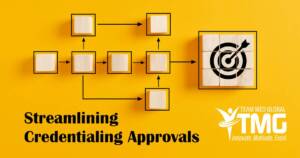 Credentialing is a complex, multi-step process, but the way we document approvals doesn’t have to be. When signatures pile up unnecessarily or processes vary from one file to the next, the approval pathway becomes unclear and inefficient. Streamlining how we document credentialing decisions isn’t just a matter of preference—it’s a necessary step toward greater clarity, consistency, and speed.
Credentialing is a complex, multi-step process, but the way we document approvals doesn’t have to be. When signatures pile up unnecessarily or processes vary from one file to the next, the approval pathway becomes unclear and inefficient. Streamlining how we document credentialing decisions isn’t just a matter of preference—it’s a necessary step toward greater clarity, consistency, and speed.
The Problem with Over-Signing
One common pitfall is requiring signatures from every approval body in the chain—department chief, credentials committee, MEC, board chair—on a single recommendation or approval sheet. While the intent is to show a clear trail of accountability, this approach often backfires. The result? Bottlenecks, confusion, and files that sit idle for weeks or even months waiting for a signature that isn’t actually needed.
Not every approval needs a handwritten endorsement. In many cases, a date is sufficient to document when a particular group reviewed and approved the file. By simplifying expectations around signatures, teams can reduce delays without sacrificing documentation integrity.
Clarifying Roles: Who Signs and Who Dates
When it comes to credentialing approvals, not every participant plays the same role. It’s important to differentiate between those making a formal recommendation and those formally approving that recommendation.
Department Chiefs or Section Leaders should review the application or reappointment file, make a recommendation, and sign and date that recommendation. This step carries weight because it reflects a professional assessment of the provider’s qualifications.
Credentials Committee, MEC, and Board members are typically functioning as collective decision-making bodies. Instead of requiring individual or chair signatures, it’s more appropriate—and efficient—to record the date each committee or board took action.
This approach supports documentation that’s both clear and consistent, eliminating unnecessary steps while still meeting regulatory and accreditation standards.
When Signatures Create Delays
Every extra signature creates a potential point of delay. Waiting on a board chair to sign off weeks after a meeting doesn’t improve the credentialing process—it only postpones onboarding, reimbursement, and patient access. In some organizations, these delays become systemic, leading to frustrated stakeholders and missed deadlines.
By reducing unnecessary touchpoints and clarifying what’s required from each approval body, organizations can eliminate these delays without compromising accuracy or compliance.
Designing an Efficient Approval Pathway
The goal is to create a standardized, streamlined method for documenting approvals. That means:
- Defining who must sign and who only needs to be recorded by date
- Using uniform templates or systems to track approvals
- Avoiding redundancy—don’t document the same approval in multiple ways
- Training all stakeholders on the purpose and flow of the decision pathway
A clean approval pathway ensures files move forward smoothly and that every action is properly recorded.
At TMG, we believe credentialing workflows should be structured, not bureaucratic. When the pathway is clear, the process flows—and the provider lifecycle moves forward without unnecessary roadblocks.

